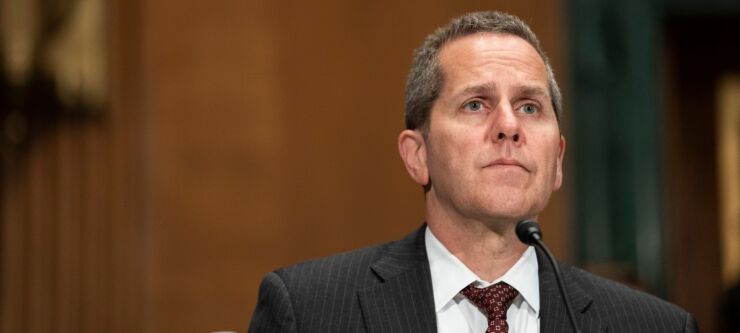
In the wake of two failures of midtier banks in the past week, the Federal Reserve is facing growing calls to adjust its regulatory regime for similarly sized institutions.
The Federal Deposit Insurance Corp.'s
While the broad requirements for the largest banks in the U.S. have been set by Congress, legal experts say the Fed has a fair amount of discretion for how to tweak its oversight of midtier banks.
"Short answer is that the Fed has some wiggle room," Cliff Stanford, a regulatory lawyer with the firm Alston & Bird and former chief enforcement lawyer at the Federal Reserve Bank of Atlanta, said.
Stanford points to Title 12 of the U.S. Code, which sets the rules for banks and banking, as giving the Fed broad authority to impose new requirements on banks with more than $100 billion of assets to protect financial stability. These include requiring resolution plans, setting counterparty credit limits and subjecting these banks to annual stress tests, he said.
Stanford said these changes can be implemented through a rule change — as the Fed has done in collaboration with the FDIC and Office of the Comptroller of the Currency on many of these matters — or by issuing an order.
Peter Conti-Brown, a professor of financial regulation at the University of Pennsylvania's Wharton School of Business, said the U.S. framework for small and medium banks is lackluster compared to many other countries that apply some version of the Basel Committee on Banking Supervision's standards to all their banks. He agreed that it is within the Fed's authority to implement this type of structure to banks with between $100 billion and $250 billion unilaterally.
"That's something that the Fed could do tomorrow," Conti-Brown said.

The Fed's authority is broad, but it tends to craft regulatory policy through formal rulemaking exercises under the Administrative Procedure Act, especially when changing existing rules made through those processes.
Megan Greene, chief economist at the Kroll Institute, a financial advisory firm, said if Silicon Valley Bank and Signature Bank faced the same liquidity coverage ratios as their larger counterparts they likely would not have failed. She expects the episode to lead to tighter regulation of smaller banks, but warns that doing so could have unintended consequences.
"One of the certainties going forward is that smaller banks will face more regulation and that probably means that more activity will be driven out of the banking sector into the shadow banking sector," Green said. "That's bad news for regulators and policymakers because we have very little visibility on what's happening under the hood in shadow banking. It means there's an opportunity for bubbles and leverage to crop up with us not really knowing until we get a market blowup."
Stanford said the first-order adjustments are likely to be made to a suite of rules issued after the passage of the 2018 Economic Growth, Regulatory Relief, and Consumer Protection Act — also known as S.2155 or the Crapo Bill, after its lead sponsor Sen. Mike Crapo, R-Idaho — which changed many of the regulatory capital requirements laid out in the 2010 Dodd-Frank Act.
"We can expect that we'll see efforts to roll back the tailoring that resulted from the 2018 reforms to Dodd-Frank," Stanford said. "This all brings back into debate whether the current capital regime, stress testing and resolution planning are adequate across the board."
The Crapo Bill amended several key provisions of Dodd-Frank, including raising the threshold for banks to be subject to the strictest oversight standards — including the full complement of capital requirement and annual stress testing — from $50 billion of assets to more than $250 billion.
S.2155 also raised the minimum threshold for enhanced capital requirements from $10 billion to $100 billion. For banks between $100 billion and $250 billion, regulators were given broad discretion over which standards and requirements they could impose as part of the law's focus on tailoring.
Ultimately, the Fed, FDIC and Office of the Comptroller of the Currency rolled out the current capital regime, in which banks with between $100 billion and $250 billion of assets are not subject to the supplementary leverage ratio or the countercyclical capital buffer. These banks, deemed Category IV banks in the Fed's framework, also face reduced liquidity capital ratio requirements and were spared from the annual stress testing faced by larger banks.

At the time, Fed Vice Chair for Supervision Michael Barr, then a law professor at the University of Michigan, publicly opposed the Crapo Bill, arguing that it weakened the oversight of all firms and gave large banks options for avoiding regulatory scrutiny. For midtier banks, he argued that rolling back capital and stress testing requirements would create unnecessary blind spots for systemic risk
"Risks aggregate across the financial system, including from institutions of a variety of sizes and types," Barr
On Monday, the central bank announced that Barr would conduct a six-week review of the Fed's supervisory and regulatory actions around Silicon Valley Bank, for which it was the bank's primary regulator. It is set to release findings by May 1. No formal actions are expected before that process is complete.
Several regulatory changes within the Fed's purview are already wrapped up in ongoing rulemaking procedures. The Fed and FDIC, for example, are gathering comments about
These ongoing actions are likely to be influenced by recent events, but they too are likely to go through a notice-and-comment rulemaking process.
While calls for regulatory reform grow after the twin failures of the past week, other voices in and around the industry say they would have made little difference for Silicon Valley Bank and Signature Bank.
The Bank Policy Institute, a Washington, D.C. lobbying group that represents the nation's largest banks, issued a statement Monday night that the issues that sparked the runs that felled the two banks — securities losses driven by rising interest rates — were the result of poor management and would not have been prevented under the pre-2018 regulatory regime. The group also argued that the bank and its regulators already had the tools to manage those risks, but they simply failed to do so.
"Unlike credit risk and liquidity risk, interest rate risk is not susceptible to being reduced to a formula; it is more art than science," BPI's statement reads. "For that reason, it has always been a core function of corporate CFOs and treasurers and of bank examiners, and not subject to prescribed regulatory formulas."
Others say the banks' reliance on uninsured deposits was another obvious shortcoming that should not require additional regulatory rules to address.
"If you stress test a small, regional bank that has lots of large deposits that are over the $250,000 mark, well, we kind of know the result that's going to happen," said Derek Horstmeyer, a finance professor at George Mason University. "If you look at the bank's deposit composition, you could probably figure out what would happen if those depositors all want their money back at once."





